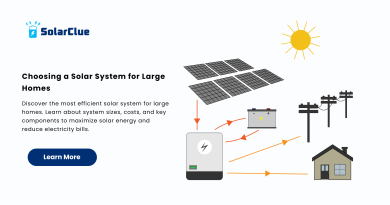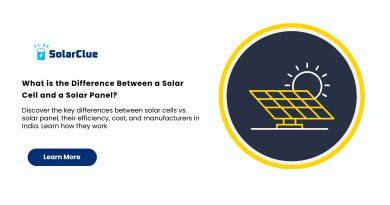How Long Before Solar Panels Pay For Themselves?
Investing in solar panels is a significant decision, and understanding the payback period is crucial for evaluating the financial viability of your investment. This blog explains the factors influencing the payback time, provides step-by-step calculations, and explores the concept of return on investment (ROI) in relation to solar panels. Additionally, we offer tips for maximizing savings and reducing the payback period.
Table of Contents
- 1 Understanding Payback Period and Return on Investment
- 1.1 Factors Affecting Solar Panel Payback Time
- 1.2 Calculating the Cost of a Solar Panel System
- 1.3 Estimating Electricity Savings with Solar Panels
- 1.4 The Impact of Government Incentives and Rebates
- 1.5 Comparing Payback Periods for Different System Sizes
- 1.6 Maximizing Solar Panel Output to Reduce Payback Time
- 1.7 Analyzing Financial Benefits Beyond Electricity Savings
- 1.8 The Role of Battery Storage in Payback Period
- 1.9 The Future of Solar Panel Costs and Payback Times
- 1.10 Tools and Calculators for Estimating Payback Period
- 1.11 Example Calculation of Solar Panel Payback Period
- 1.12 Conclusion
- 1.13 FAQs
Understanding Payback Period and Return on Investment
Payback Period: The payback period is the amount of time it takes for the savings from a solar panel system to equal the initial investment cost. After the payback period, the system essentially generates free electricity, leading to continued savings.
Return on Investment (ROI): ROI measures the profitability of an investment. In the context of solar panels, it’s the percentage of the investment cost recouped through savings over a specific period, typically calculated on an annual basis.
Factors Affecting Solar Panel Payback Time
Several factors influence how quickly you can recover the cost of your solar panel system:
| Factor | Impact on Payback Time |
|---|---|
| System Cost | Higher upfront costs extend the payback period. |
| Electricity Rates | Higher electricity rates shorten the payback period. |
| Solar Panel Efficiency | More efficient panels produce more electricity, reducing payback time. |
| Government Incentives | Incentives and rebates can significantly reduce upfront costs. |
Calculating the Cost of a Solar Panel System
The first step in determining the payback period is calculating the total cost of the solar panel system, including installation, equipment, and any additional features like battery storage.
Example:
- System Size: 5 kW
- Cost per Watt: ₹40
- Total System Cost: 5,000 W × ₹40/W = ₹2,00,000
Estimating Electricity Savings with Solar Panels
Next, estimate your annual electricity savings based on the amount of electricity your solar panels generate and your local electricity rates.
Example:
- Annual Production: 7,000 kWh (estimated based on location and panel efficiency)
- Electricity Rate: ₹6 per kWh
- Annual Savings: 7,000 kWh × ₹6/kWh = ₹42,000
The Impact of Government Incentives and Rebates
Government incentives and rebates can significantly reduce the upfront cost of a solar panel system, thereby shortening the payback period.
Example:
- Incentive: 30% rebate on total system cost
- Rebate Amount: ₹2,00,000 × 30% = ₹60,000
- Net System Cost: ₹2,00,000 – ₹60,000 = ₹1,40,000
Comparing Payback Periods for Different System Sizes
Larger systems often have a longer payback period due to the higher upfront cost, but they also generate more electricity and savings over time. Comparing the payback periods for different system sizes can help you determine the most cost-effective option.
| System Size (kW) | Total Cost (₹) | Annual Savings (₹) | Payback Period (Years) |
|---|---|---|---|
| 3 kW | ₹1,20,000 | ₹25,200 | 4.8 |
| 5 kW | ₹2,00,000 | ₹42,000 | 4.8 |
| 7 kW | ₹2,80,000 | ₹58,800 | 4.8 |
Maximizing Solar Panel Output to Reduce Payback Time
To shorten the payback period, maximize the output of your solar panels by ensuring they are installed in an optimal location with maximum sunlight exposure, regularly maintained, and free from shading.
Analyzing Financial Benefits Beyond Electricity Savings
Beyond direct electricity savings, consider other financial benefits of solar panels, such as increased property value, tax credits, and potential income from selling excess electricity back to the grid.
The Role of Battery Storage in Payback Period
Battery storage can extend your savings by allowing you to store excess electricity generated during the day for use at night. However, the cost of batteries can also extend the payback period, so it’s essential to evaluate whether the additional expense is justified.
The Future of Solar Panel Costs and Payback Times
As solar panel technology improves and costs continue to decrease, payback periods are expected to shorten. Additionally, advances in energy storage and smart grid technologies may offer new ways to maximize savings.
Tools and Calculators for Estimating Payback Period
Several online tools and calculators can help estimate the payback period for your solar panel investment, taking into account system size, location, electricity rates, and available incentives.
Example Calculation of Solar Panel Payback Period
| Factor | Calculation | Example Value (₹) |
|---|---|---|
| Total System Cost | System Size × Cost per Watt | ₹2,00,000 |
| Annual Savings | Annual Production × Electricity Rate | ₹42,000 |
| Government Incentives | Total System Cost × Incentive Percentage | ₹60,000 (30%) |
| Net System Cost | Total System Cost – Incentives | ₹1,40,000 |
| Payback Period | Net System Cost ÷ Annual Savings | 3.33 Years |
Conclusion
Calculating the payback period for a solar panel investment is essential for understanding the financial benefits of going solar. By considering factors such as system cost, electricity rates, and government incentives, you can estimate how long it will take to recover your investment and begin enjoying free electricity. As solar technology advances and costs continue to decline, the payback period is expected to shorten, making solar panels an increasingly attractive option for homeowners and businesses alike.
Here at SolarClue®, we offer a smart, practical, and “beautiful” solution. You will be answered for all the questions related to Solar.
We provide all kinds of brands that are the Best Solar panels in India.
If you are the one who is planning for the solar power system. Don’t hesitate to contact our team!
Looking forward to empowering you with solar energy, just like hundreds of our other clients!
FAQs
1. What is the payback period for a solar panel system?
The payback period is the time it takes for the savings from a solar panel system to equal the initial investment cost.
2. How is the payback period calculated?
The payback period is calculated by dividing the net system cost (after incentives) by the annual electricity savings.
3. What factors affect the payback period of solar panels?
Factors include the total system cost, electricity rates, solar panel efficiency, and government incentives.
4. How can I shorten the payback period for my solar panels?
You can shorten the payback period by maximizing solar panel efficiency, taking advantage of government incentives, and reducing installation costs.
5. What is the typical payback period for solar panels?
The typical payback period for solar panels ranges from 4 to 7 years, depending on the factors mentioned above.


